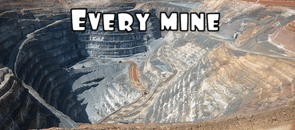Google Earth Elevation Data
Method 1: Cross-Checking with Google Earth Elevation Data:
The easiest way to verify elevation values or contours
provided in a mining plan is to create a KML file of the area of interest in
KOMPAS and view it in Google Earth. By moving the mouse pointer over the area,
users can see the elevations in meters and even draw sections to view elevation
profiles.
Method 2: Capturing Boundary Pillars with Mine Mapper App:
Using Mine Mapper App, users can capture the boundary
pillars and view the corresponding Google Map elevation values.
Method 3: Uploading KML Files to Mine Mapper Measurement
Tool:
Upload the KOMPAS-generated KML file of the mine area to the
Mine Mapper measurement tool to display Google Map elevations against each
pillar.
However, it's important to note that the elevation provided
by Google Earth is not the actual elevation above mean sea level. For example,
if you measure the elevation in the Arabian Sea and get a value of 19 meters,
it's unclear whether this represents 19 meters above the ellipsoid or another
reference point. Google does not disclose the source of their elevation data,
making it challenging to determine the exact reference point.
From the above image, it can be observed that the Google
elevation in the Arabian Sea is 19 meters, while on the runway of
Thiruvananthapuram airport, it is 25 meters. When considering relative
elevation, it can be determined that the runway is 6 meters above sea level.
SRTM 30m resolution elevation data:
The SRTM 30m resolution data is widely used worldwide by
scientists and planners. For SRTM data, the unit of elevation is meters
referenced to the WGS84/EGM96 geoid. Since the EGM96 geoid closely resembles
the global mean sea level (the average height of the entire ocean surface), the
SRTM data closely resembles Survey of India toposheet elevation data, although
there are minor differences. For a geologist, SRTM 30 m resolution data will be
more helpful than Google elevation data, which is off by 19 m as the sea level
in the Indian coast is around 19 m in Google data.
It is important to note that SRTM data provides the average elevation of a 30 m square, as the resolution of the data is 30 m. Additionally, it is essential to remember that the SRTM survey took place in February 2000. Therefore, man-made pits formed before February 2000 will be depicted as pits in the SRTM data, whereas in Survey of India toposheets, such pits may not be represented.
Survey of India Toposheet Elevations:
Anyone familiar with the history of the Survey of India is
likely aware of the Great Trigonometrical Survey (GTS), a project initiated in
1802 to conduct a precise survey across the Indian subcontinent. The data
collected during the GTS formed the basis for the topographical maps and
toposheets still in use today, including in mining activities. Elevations
depicted in toposheets are referenced to mean sea level, with Bombay (Mumbai)
serving as the reference point for elevations on these maps.
Both 1:5000 toposheets and the Open Series Maps (OSM) use
the Transverse Mercator projection, which is suitable for mapping large areas
with relatively low distortion. However, if you georeference a toposheet (using
the Transverse Mercator projection) and overlay it on Google Earth or Google
Maps (which use the WGS84 geographic coordinate system), there will likely be a
noticeable shift. The amount of shift can vary depending on the specific area,
but it can be significant, potentially several meters or more. This means that
geologists who directly overlay a toposheet on Google Earth or Google Maps may
experience a shift, which can impact volume computations, especially in areas
with undulating topography.
In the following example, there is a shift of around 140 meters between the toposheet and Google Earth. Therefore, it is not advisable to directly overlay a KML file generated in Google Earth or KOMPAS onto a georeferenced toposheet due to this shift. In the example provided
below, the contour values shown in the toposheet cannot be directly
superimposed onto the KML boundary map.
SRTM contour values perfectly matches the undulations is depicted in the following image:
The original surface of a quarry can be reconstructed using the SRTM data. The following example shows recreation of original surface:
Recommendations:
1. Use Google Earth to plot the KML file generated in KOMPAS to understand the topography and view it in 3D.
2. Calculate the SRTM elevations of the boundary pillars (or any point within the mine area) using the Mine Mapper SRTM Elevation Measurement tool.
3. Keep in mind that SRTM elevation data was collected in February 2000 and accounts for man-made pits formed before that date.
4. Do not rely on elevations provided by Google Earth, as there is a significant difference in elevation compared to Toposheets.
5. SRTM elevations closely match those of Toposheets, making them a reliable source.
6. When RQPs use dGPS surveys, verify the reported values by comparing them with SRTM values. While dGPS measurements are reliable, it's important to correct the elevation values based on the appropriate geoid model.
7. Request RQPs to clearly document the methods used to collect elevation data in the mining plan.
8. Establish a permanent benchmark outside the mine area (just beyond the lease area) for future reference, and record the benchmark details in the mining plan.




















0 Comments